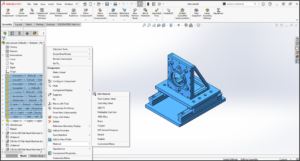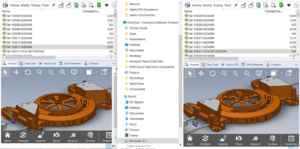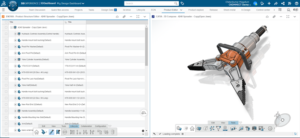SOLIDWORKS Composer offers rich solutions in 3D data support, technical illustration, animations, 2D and 3D publishing, process automation, assembly process simulation, and viewing. SOLIDWORKS Composer is the core offering which features comprehensive 3D data import and export, technical illustrations, raster and vector images, exploded views, bills of materials (BOM), static animations, interactive configurations, and 2D and 3D publishing.
Documenting a product is traditionally one of the biggest bottlenecks to getting a product to market: once a design is created and all the prototypes are tested, a number of different documents need to be created. Creating product documentation can be a very costly part of any product’s lifecycle, and waiting until after the design is completed before using it downstream in different departments can be difficult at best.
When documenting a product, everything from marketing material all the way to assembly instructions and end user owner’s manuals needs to be accounted for and created.
At most businesses, this is a tedious task that requires a lot of text, CAD images, and sometimes even requires taking photographs of a final product. If there is a last minute design change, or if there’s a component that is added or changed, usually documentation will have to be halted while this is changed, or sometimes the documentation will still be sent with the product even though it is out of date.
These steps can be serious bottlenecks to the product release. But, more importantly, they can cause the documentation to be confusing or difficult for the end users.
Typically, the first interaction customers often have with a product starts with the documentation (in the form of an assembly manual or owner’s manual). If this doesn’t look good, is difficult, out of date, poorly assembled, etc., it can negatively impact the decision of the customer to purchase additional products (not to mention damage your brand image).
By re-inventing and rejuvenating your product documentation and the way that it’s approached, you can take advantage of your designs to their full extent, generate great looking documentation with ease, and get a product to market much faster.
SOLIDWORKS Composer creates documentation from CAD models quickly and easily, allowing you to develop and publish detailed, precise, and visually stunning graphical content for use in things like assembly instructions, marketing material, high-res images, and owner’s manuals. Here’s the fantastic part – the software updates the documentation with the CAD designs – so there’s no need to recreate documentation if there’s a design change.
1. Leveraging your 3D CAD data downstream:
In my visits with many companies one of the biggest hassles I encounter is a complete disconnect between documentation and design. As a product is being developed, engineers have no easy way to get the information from a design department over to documentation. However, by using SOLIDWORKS Composer there’s a big efficiency gain. You use existing 3D data and start to immediately create views to show how items fit together, how a part is assembled, and add arrows and callouts. One of the many powers of Composer is its cross platform capabilities. It can handle many different CAD formats, and leverage that data directly into documentation.
Once you’ve got 3D content that you need, it’s simple to export/publish this out to any format you want, including high-resolution images for traditional documentation like owner’s manuals, safety instructions or more cutting edge content like interactive assembly instructions and purchasing sheets. The graphics quality is unparalleled, and the content is always going to be accurate because it’s pulling directly from the engineering design.

2. Synchronizing design and documentation:
Another common bottleneck with product documentation are delays waiting for a design to be completed before documentation begins. In most companies, documentation takes place after a design has hit the production floor, sometimes even well beyond that. In most cases, this requires a completed design to start creating instructions on how it is assembled, what part order numbers are, and how to start creating things like a BOM and instructions for maintenance. This often requires engineers to create tedious drawings with assembly procedures, or sometimes even requires photographs to be taken of a completed product.
By using Composer, you can start creating documentation in parallel to the design process. This allows you to start creating documentation and show how an assembly is going to be fit together before the design is completed. You can also start to create things like animations, interactive instructions (useful for websites), and even BOM listings before the product is finished, and when the design updates, you can simply update the documentation with the latest geometry changes, and everything will update downstream. This is a great way to start developing documentation at the same time as your design is being iterated, allowing you to have both being generated in parallel.

3. Enhanced Communication:
Another huge issue, especially with the globalization of today’s product market, is effectively communicating a design visually. Any time there is text on a product that describes instructions of any kind, this can not only be difficult and costly to translate, but it can create room for error if there is any sort of confusion. By creating very illustrative high-end graphics with effective annotations you can minimize or even eliminate the need for written descriptions.
In addition, Composer can generate a wide range of comprehensive documentation. It can easily provide detailed animations, interactive scalable vector files with BOM highlighting, and even cutting edge interactive work instructions for touch screens. And, rather than having to document an assembly step as a series of textual information, the same information can be relayed by a simple image, or an interactive 3D view. The possibilities are staggering, and some companies are even eliminating the need to have any sort of 2D paper documentation, opting instead for tablets on the shop floor for work instructions. The benefits also extend all the way down to the customer level , ensuring that the product that the customer purchases is documented cleanly and effectively, allowing for a positive interaction as a first point of contact.

See Video:https://ckonnect.in/solidworks/products/technical-communication/solidworkscomposer/composervideos/
-RegardsBhanu Prakash





















